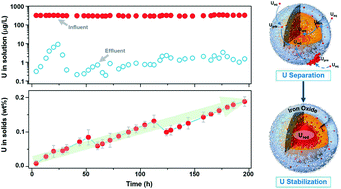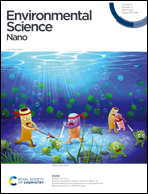Enrichment of uranium from wastewater with nanoscale zero-valent iron (nZVI)†
Abstract
The core–shell structure of nanoscale zero-valent iron (nZVI) offers multiplex solution and surface chemistry for reliable and high-efficiency enrichment and separation of uranium from low-level sources such as wastewater, groundwater, and even seawater. In this work, the reduction, enrichment and separation of uranium from uranium-tailings wastewater were demonstrated in continuous-flow reactors. Specifically, a two-stage continuous flow stirred tank reactor system was operated for 193 h. 497.7 L of radioactive uranium-tailings wastewater containing ∼331 μg U per L was treated with a total of 60.22 g of iron nanoparticles. It produced reacted nZVI containing ∼0.19 wt% uranium, well above typical high-grade uranium ores. The treated wastewater had an average concentration of just 1.47 μg U per L. High-resolution elemental mappings performed with aberration corrected scanning transmission electron microscopy (Cs-STEM) indicated that uranium was deposited largely in the core area of the reacted nZVI particles with chemical reduction as the principal enrichment mechanism. Together with our previous work on nZVI, this further offers growing evidence of a cost-effective nanotechnology for simultaneous pollution control and resource recovery.



 Please wait while we load your content...
Please wait while we load your content...